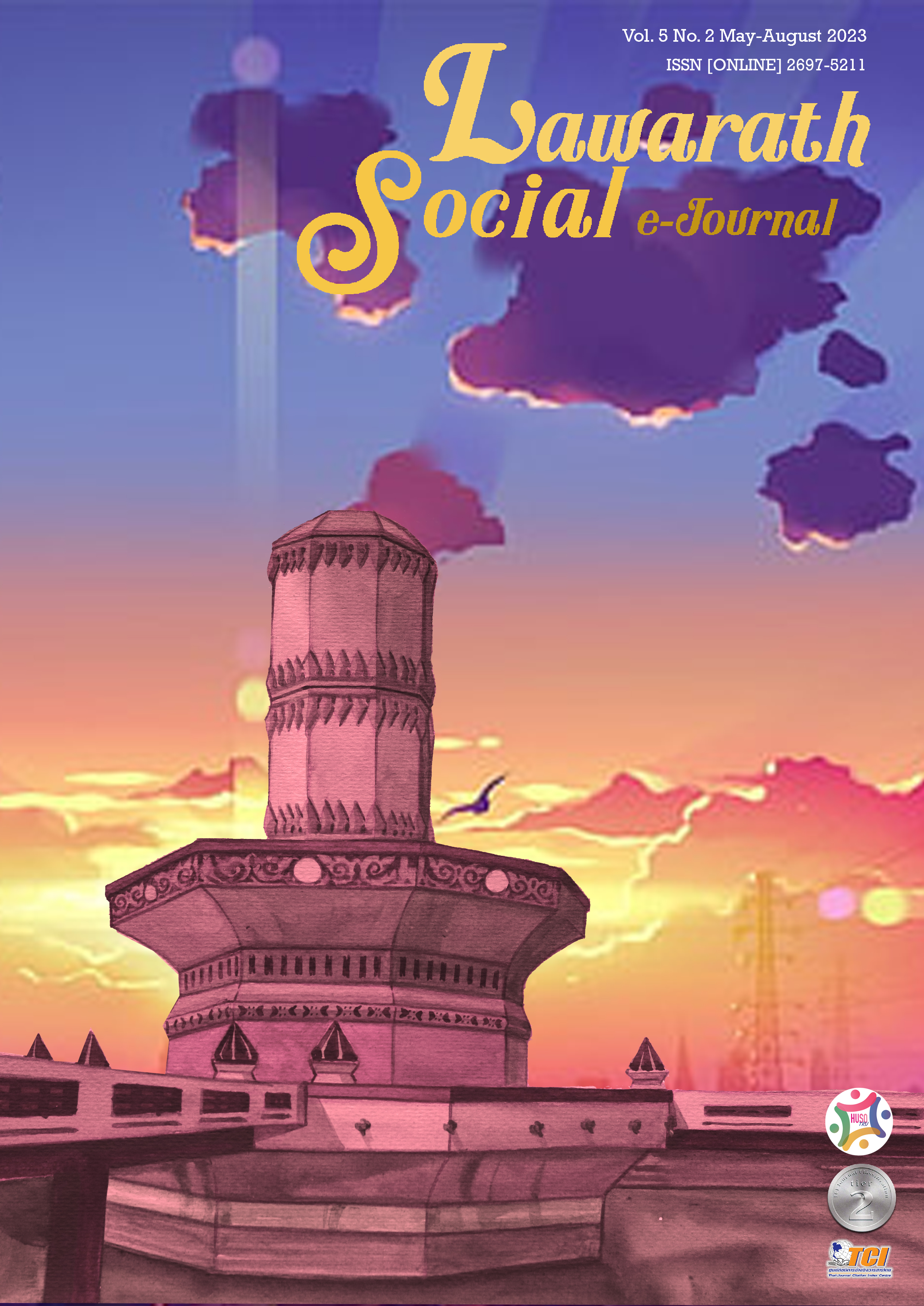History of Lao Wiang Community from Objects, Bang plama District, Suphanburi Province
Keywords:
Community History, Lao Wiang , ObjectsAbstract
The research aims to study the history of the Lao Wiang community and their knowledge of decorating the house with local objects and utensils at Moo 8 and Moo 10. The tool used to collect the data was an interview that was done with a total of thirty informants from the two communities. The results showed that the two communities were related by kinship. There were two important historical factors influencing the community: the suitable settlement for arable land and religious beliefs. Lao Wiang people came from Wat Maniwan and other nearby temples known as Ban Mae Nam. The reason for their immigration was due to their farming career which the current land was more fertile. In terms of home decoration, the usefulness and simplicity of the objects were taken into great consideration because the residents usually owned Thai classic-style houses. Moreover, the community normally used local wooden material which is durable and also represents the wisdom and identity of Lao Wiang that has been adapted to the modern way of life and environment. This reflected how people reserved the beliefs that were passed down from their ancestors. The types of objects used for home decorations were classified into four categories including photographs, furniture, daily appliances, and decoration items.
Downloads
References
กระทรวงศึกษาธิการ. (2522). เสด็จประพาสต้นในรัชกาลที่ 5 พระราชนิพนธ์ในพระบาทสมเด็จพระจุลจอมเกล้าเจ้าอยู่หัว และพระนิพนธ์สมเด็จกรมพระยาดำรงราชานุภาพ. กรุงเทพฯ: โรงพิมพ์คุรุสภาลาดพร้าว.
เจริญ ธรรมโกศล. (2564, ธันวาคม 16). สัมภาษณ์.
ดวงเงิน พูลผล, และคนอื่น ๆ. (2548). ศิลปหัตถกรรมพื้นบ้านและการผลิตเนื่องมาจากระบบนิเวศน์. นครปฐม: สถาบันวิจัยและพัฒนา มหาวิทยาลัยศิลปากร.
ดำรงราชานุภาพ, สมเด็จพระเจ้าบรมวงศ์เธอ กรมพระยา. (2519). เสด็จประพาสต้น. กรุงเทพฯ: แพร่พิทยา.
ธิดา ชมภูนิช. (2539). การศึกษาศิลปหัตถกรรมไทยโซ่งในจังหวัดนครปฐม. กรุงเทพฯ: โรงพิมพ์พิทักษ์อักษร.
ธิดา สาระยา. (2529). ประวัติศาสตร์ท้องถิ่น: ประวัติศาสตร์สัมพันธ์กับสังคมมนุษย์. กรุงเทพฯ: เมืองโบราณ.
เทศบาลต้นคราม อำเภอบางปลาม้า จังหวัดสุพรรณบุรี. (ม.ป.ป.). แผนพัฒนาท้องถิ่นสี่ปี พ.ศ. 2561-2564. สุพรรณบุรี: ผู้แต่ง.
นรินทร์ รักนุ้ย. (2549). การศึกษาเครื่องจักสานสุพรรณบุรี กรณีศึกษา: กลุ่มบ้านโพธิ์ศรี ตำบล บางปลาม้า อำเภอบางปลาม้า จังหวัดสุพรรณบุรี. วิทยานิพนธ์ปริญญามหาบัณฑิต มหาวิทยาลัยศรีนครินทรวิโรฒ.
บังอร ปิยะพันธุ์. (2541). ลาวในกรุงรัตนโกสินทร์. กรุงเทพฯ: สำนักงานกองทุนสนับสนุนการวิจัย.
วรรณพร บุญญาสถิต, ฉันทัส เพียรธรรม, และเทพธิดา ศิลปรรเลง. (2559, มกราคม-เมษายน). พัฒนาการทางประวัติศาสตร์ของกลุ่มชาติพันธุ์ลาวเวียง อำเภออู่ทอง จังหวัดสุพรรณบุรี. JOURNAL OF NAKHONRATCHASIMA COLLEGE, 11(1), 26-38.
วิบูลย์ ลี้สุวรรณ. (2527). ศิลปหัตถกรรมพื้นบ้าน. กรุงเทพฯ: ปาณยา.
______. (2558). พจนานุกรมหัตถกรรมเครื่องมือเครื่องใช้พื้นบ้าน. กรุงเทพฯ: เมืองโบราณ.
ศรีศักร วัลลิโภดม. (2533). พิพิธภัณฑ์และประวัติศาสตร์แห่งท้องถิ่น:กระบวนการเรียนรู้ร่วมกัน. กรุงเทพฯ: มูลนิธิเล็ก-ประไพ วิระยะพันธ์.
สุนันทา เงินไพโรจน์. (2559). รูปแบบบ้านทรงไทยในพื้นที่ตำบลจรเข้ใหญ่ อำเภอบางปลาม้า จังหวัดสุพรรณบุรี. กรุงเทพฯ: สถาบันบัณฑิตพัฒนศิลป์.
______. (2561). การศึกษาภูมิปัญญาท้องถิ่นการสร้างบ้านทรงไทยที่บ้านอ่าวหม้อแกงและบ้านสองคลอง ตำบลโคกคราม อำเภอบางปลาม้า จังหวัดสุพรรณบุรี. กรุงเทพฯ: สถาบันบัณฑิตพัฒนศิลป์.
สุภาภรณ์ จินดามณีโรจน์. (2553). ประวัติศาสตร์สังคมของชุมชนลุ่มน้ำท่าจีน. กรุงเทพฯ: สร้างสรรค์บุ๊คส์.
องค์การบริหารส่วนตำบลจรเข้ใหญ่ อำเภอบางปลาม้า จังหวัดสุพรรณบุรี. (ม.ป.ป.). แผนพัฒนาท้องถิ่น พ.ศ. 2561–2565. สุพรรณบุรี: ผู้แต่ง.
อินทิรา พงษ์นาค, และศุภกร ดิษฐพันธ์. (2558, กันยายน-ธันวาคม). อัตลักษณ์ชุมชนเมืองโบราณอู่ทอง จังหวัดสุพรรณบุรี. Veridian E-Journal, Silpakorn University (Humanities, Social Sciences and Arts) ฉบับภาษาไทย มนุษยศาสตร์ สังคมศาสตร์ และศิลปะ, 8(3), 511-523.
Thompson, P. R. (1978). The Voice of The Past: Oral History. New York: Oxford University Press.
Downloads
Published
How to Cite
Issue
Section
License

This work is licensed under a Creative Commons Attribution-NonCommercial-NoDerivatives 4.0 International License.



